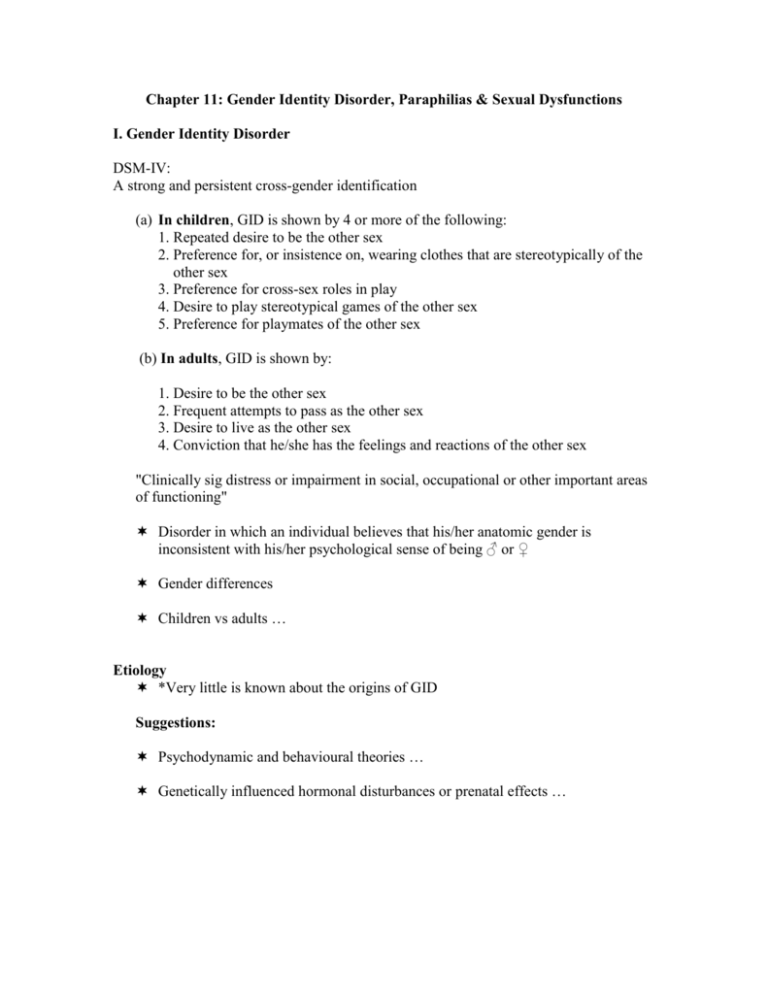
Chapter 11: Gender Identity Disorder, Paraphilias & Sexual Dysfunctions
I. Gender Identity Disorder
DSM-IV:
A strong and persistent cross-gender identification
(a) In children, GID is shown by 4 or more of the following:
1. Repeated desire to be the other sex
2. Preference for, or insistence on, wearing clothes that are stereotypically of the
other sex
3. Preference for cross-sex roles in play
4. Desire to play stereotypical games of the other sex
5. Preference for playmates of the other sex
(b) In adults, GID is shown by:
1. Desire to be the other sex
2. Frequent attempts to pass as the other sex
3. Desire to live as the other sex
4. Conviction that he/she has the feelings and reactions of the other sex
"Clinically sig distress or impairment in social, occupational or other important areas
of functioning"
Disorder in which an individual believes that his/her anatomic gender is
inconsistent with his/her psychological sense of being ♂ or ♀
Gender differences
Children vs adults …
Etiology
*Very little is known about the origins of GID
Suggestions:
Psychodynamic and behavioural theories …
Genetically influenced hormonal disturbances or prenatal effects …
Treatment
Attempts have been made to encourage gender-appropriate and discourage crossgender behaviour among GID children ...
Other opinion … allow child to live as other gender …
Some eventually request hormonal treatment or surgery to reassign them to the
opposite sex ...
Reassignment
– Process …
– Careful evaluation; live as other gender for _____
– Hormones
– Surgery …
–
Is it covered by OHIP?
Outcomes of gender-reassignment surgery:
II. Sexual Preference Disorders
–
Gender difference: Majority = _____
–
Diversity …
Paraphilia
Recurrent, intense fantasies, urges or behaviours involving …
Fetishism
Non-living objects
Diversity! … note: __________ for DSM diagnosis
Origins … (learning theories: conditioning &
observational learning)
Partialism …
Transvestic Fetishism
Cross-dressing
Profile …
Typically, in private
Sexual Masochism
Being humiliated, beaten, bound or otherwise made to suffer
Practices …
Hypoxyphilia
Sexual Sadism
Acts that cause phys or psych suffering to another person
Sadomasochism
Mutually gratifying sexual interaction involving both S & M acts;
many times, switch roles
Exhibitionism
Exposure of one's genitals to an unsuspecting stranger
Typically does NOT seek sex activity …
Voyeurism
Watching an unsuspecting person who is either naked,
disrobing or engaged in sexual activity
Typically does NOT seek sex activity …
Frotteurism
Touching or rubbing against a non-consenting person
Paraphilia
Recurrent, intense fantasies, urges or behaviours involving …
Pedophilia
Sexual activity with a prepubescent child
Must be at least 16 yrs old & at least 5 yrs older than victim;
mostly ♂
Diversity!
Profile: MOST are …
NOTE: not all child molesters have pedophilia!!
Other
Klismaphilia
Urophilia
Coprophilia
Necrophilia
Bestiality
Scatalogia
Theoretical Perspectives
Learning Theories:
Conditioning
Observational Learning
Treatment
Behavioural
Therapy
Aversive Conditioning
CBT
•
•
•
Medications
Adaptive thoughts
Social skills
Stress-mgmt skills
III. Sexual Dysfunctions
What is normal sexual functioning? ...
Masters and Johnson:
Sex response cycle:
– changes that occur in the body with increased sexual arousal, orgasm and
the return to the unaroused state
– Terms:
• Vasocongestion
•
Myotonia
– 4 stages:
1. Excitement
–
–
–
–
Erection in the male
Vaginal lubrication in the female
Increased myotonia, heart rate, and blood pressure
Sex flush
2. Plateau
–
–
–
Increases in vasocongestion, muscle tension, heart rate, and blood pressure
Orgasmic platform
Sex skin
3. Orgasm
–
Contractions!! …
4. Resolution
–
–
Body gradually returns to its prearoused state
Refractory period
III. Sexual Dysfunctions
DSM-IV categorizes sex dysfunctions according to which of the 3 phases is
affected: desire, arousal or orgasm; Separate category: pain = primary
complaint
Specifiers:
– Lifelong vs acquired
– Generalized vs situational
Causes marked distress or interpersonal difficulty
Sexual Desire
Disorders
Hypoactive sexual desire disorder
Persistent or recurrent deficiency of sexual fantasies and desire for sex
Sexual aversion disorder
Persistent or recurrent, extreme aversion to, and avoidance of, almost
all genital sex with a partner
Sexual Arousal
Disorders
emotionally and
mentally interested
in sex but person
does not become
physiologically
aroused
Female sexual arousal disorder
Persistent or recurrent inability to attain or maintain arousal "until
completion of the sexual activity”
Orgasmic
Disorders
Female orgasmic disorder (anorgasmia)
Persistent or recurrent delay in, or absence of, orgasm following
normal excitement
Male erectile disorder
Persistent or recurrent inability to reach or sustain an erection "until
completion of the sexual activity"
Male orgasmic disorder
Same as above
Premature Ejaculation
Persistently ejaculates with minimal stimulation and often before or
immediately following intromission (entry of penis into vagina)
Sexual Pain
Disorders
Dyspareunia
Genital pain associated with intercourse; must not be caused
exclusively by lack of lubrication or vaginismus
Vaginismus
Persistent involuntary contraction of the muscles in the outer 3rd of
the vagina upon attempts at penetration
Etiology
Biological
Perspectives
–
Learning
Perspectives
Cognitive Factors
–
–
Role of
conditioned
anxiety
The following can affect desire &/or sex functioning:
1.
2.
3.
4.
Problems in Relationships
Learning
sex skills …
Sociocultural Perspectives
Psychological Factors
Treatment
Sex Therapy
Sex desire disorders
– Treat sex
dysfunctions by
modifying
couple’s
interactions
Arousal disorders
Orgasmic disorders
Pain disorders
Biological
Treatments
•
For ED:
• Silicone implants
• Hormone treatments
• Vascular surgery
• Viagra (note: mixed results for ♀)
• Injections of muscle relaxants
•
For premature ejaculation: ______________________








